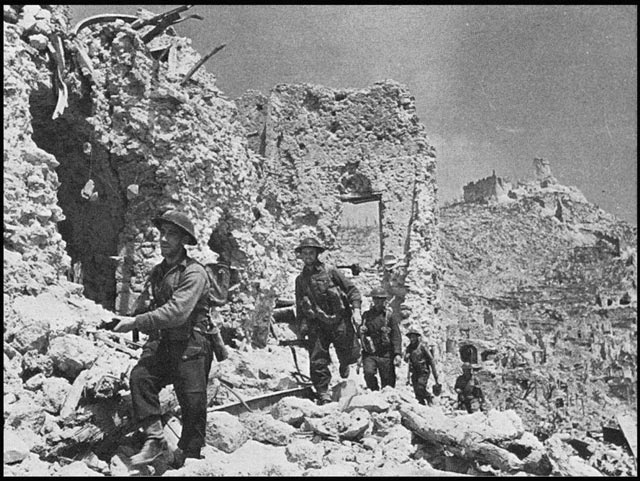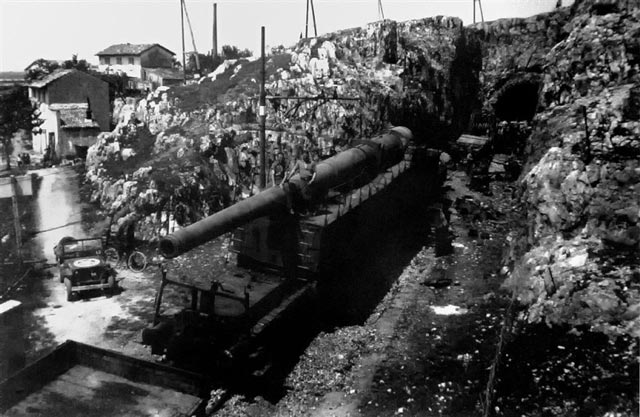Italy Was Defensible, But it Required the Right Man
 |
| The ruins of the Benedictine Abbey of Monte Cassino after the battles along the Gustav Line in 1944. |
The German decision to defend Italy produced one of the most successful Axis defensive victories of World War II. At a very reasonable cost in units, the Wehrmacht scored several propaganda victories and restored the confidence that had been lost in “Tunisgrad,” the loss of its foothold in North Africa.
Whether or not to defend Italy or retreat to the Alps was fiercely debated within the Wehrmacht. There were two schools of thought, with
Erwin Rommel advocating an immediate withdrawal to the north and Albert Kesselring insisting that he could keep the Allies far to the south. The issue came to a head In September 1943, after the Allies invaded the mainland and faced a furious German counterattack at the beachhead in Salerno. The issue had huge political ramifications, as there were still many loyal Italian fascists and industries south of the Alps that could contribute to the war effort. Mussolini and the Axis in general also would benefit by retaining Rome.
 |
| Field Marshal Erwin Rommel in discussion with Field Marshal Kesselring in June 1942 (Moosmüller, Federal Archive Bild 101I-785-0300-33A). |
By mid-1943, Erwin Rommel was a troubled man due to the loss of the Afrika Korps. He basically felt that the war was lost, though he did not come right out and say it. The best option in his view was to pull back into a concentrated area of power supported by geographical features favorable to the defense. This tactic was favored within the Wehrmacht and was used successfully at the “Gotenkopf” on the Taman Peninsula, at Tunisia in North Africa, and in the Courland Pocket on the Eastern Front. This was akin to an inferior army retreating to the castle walls rather than being slaughtered out in the open field. The Courland pocket and several German bases on the Atlantic French coast held out until the end of the war against far superior Allied forces using this strategy.
Kesselring, on the other hand, was renowned throughout the Wehrmacht for being an optimist who felt that he could achieve objectives that others felt were unachievable. Everybody knew that Hitler preferred to not give up ground without a struggle ("We must bleed them white for every meter of ground!"), and Kesselring had a plan to do just that in Italy. Keeping the enemy as far away from the Reich's cities was extremely important to the war effort because it lengthened the distance the Allied bombers had to fly and increased the Luftwaffe's odds of shooting them down. As a Luftwaffe general, Kesselring was very sensitive to airpower and how withdrawals only helped the enemy's bomber streams get through to their targets. The further away were the Allied airbases, the better.
Since both men had marshal’s batons, this was a dispute that only Hitler could resolve.
 |
| How would you respond to this situation? Hitler received two completely different and irreconcilable recommendations from two of his best field marshals. |
The amazing thing is that Hitler even considered Rommel's suggestion of voluntary withdrawal. Hitler routinely rejected such requests from other generals. However, Rommel was Hitler’s favorite, which is difficult to remember given all that came later. Rommel argued, based upon his experience in North Africa, that Allied command of the air made any attempt to hold central and southern Italy foolhardy. He advocated the construction of a defensive line on the southern slope of the Alps to which the German formations should immediately withdraw. Hitler was hesitant to disregard this advice from the commander who had produced so many victories against the Western Allies in North Africa.
 |
| The US invasion of mainland Italy was not as easy as it may appear in retrospect. This photograph shows American soldiers pinned down on the beach landing mats at Salerno (Official US Coast Guard photograph, Gift of Stacy Hutchinson, from the Collections of the National WWII Museum). |
So, to “split the baby” and create a “two-track” command system, Hitler formed Army Group B in northern Italy (not the same as the one destroyed in the Soviet Union at Stalingrad). He put it under Rommel’s control. This was a bit of a slight to Kesselring, who was technically Rommel’s superior as Commander, Southeast Theater. To make the decision palatable to Kesselring, Hitler also formed Army Group C, composed of all units in southern Italy, and placed it under Kesselring’s control. Kesselring’s area was defended by the 10th Army. This formation could have used reinforcement from Rommel’s forces in northern Italy, but German generals rarely surrendered units to fellow commanders except under compulsion. Hitler, feeling he had made his decision, did not force Rommel to help Kesselring. The net result was that Kesselring did not receive reinforcements from the north when they might have made a difference at Salerno.
 |
| Among the ruins of the Monte Cassino abbey, a German Fallschirmjaeger (paratrooper) gives instructions to a mortar team (Credit: FonthillMedia). |
Kesselring made the best of a bad situation despite his understrength units and the complete destruction of the Luftwaffe during the battle at Salerno. As a Luftwaffe commander, unlike Rommel, he intimately knew both the strengths
and limitations of airpower. He analyzed the situation shrewdly with an eye toward Allied aerial supremacy and came up with a brilliant plan. The topography of southern Italy gave him the solution. He established the Gustav Line south of Rome. Based on the mountain ranges anchored by Monte Cassino, he realized that he did not require much Luftwaffe support to defend this rough ground. Kesselring also had the advantage of some excellent subordinate commanders, including the superb panzer general
General Hans Hube (before he was called away to command First Panzer Army) and the vastly underrated (by historians) General Frido von Senger und Etterlin. Senger was both a brilliant tactician and also a bit of a diplomat, which came in very handy in Italy. The Wehrmacht men in southern Italy were all veterans of the tactically brilliant
defense of Sicily led by Hube and had developed successful defensive tactics there.
 |
| The 2nd NZ Infantry Division marches into the town of Monte Cassino past the ruins of the Hotel Des Roses. The hills and ruins were perfectly suited for the defensive battles planned out by Kesselring (Credit: FonthillMedia). |
After months of deliberation (he was notorious for slow decisions on important questions), Hitler finally made up his mind. On 6 November 1943, he named Kesselring as supreme commander in Italy and reassigned Rommel to Normandy. Thus, Kesselring’s optimism prevailed over Rommel’s pessimism.
 |
| "Anzio Annie" was a Krupp K5 rail gun. First used in 1940 for the invasion of France, it became notorious for shelling the Americans at Anzio. The barrel of this gun is at an impressive 280mm and was capable of launching 550lb shells over 38 miles. Note the turntable which made precision aiming possible. Anzio Annie was later captured by the Allies at Civitavecchia and now is on display in the United States at Fort Lee, Virginia. |
Hitler made the right call. The decision paid off beautifully. Kesselring’s defense of the Gustav Line was so successful that it drove
Winston Churchill crazy. At this stage of the war, the British still essentially controlled strategy in the European Theater of Operations. To speed things up, Churchill and his generals cooked up the Anzio landings (Operation Avalanche), intended to break the stalemate. This turned into a disaster that was just short of a catastrophe, as the Germans quickly sealed the landing grounds and came very close to pushing the US VI Corps of General Mark Clark's Fifth Army into the sea. The US Army had its highest "battle fatigue" rate of the war at Anzio. US General John Lucas was fired on 22 February 1944 as a result. Huge German guns such as "Anzio Annie" and the "Anzio Express" battered the Allies who had little cover and could only hope and pray the big shells did not land near them.
 |
| The Anzio Express was another of the two K5 guns used at Anzio. The name came from the express train-like sound of the shells. |
The Gustav Line held out until May 1944 and prevented the capture of Rome until June. It became a huge German propaganda victory, with
Reichsmarchal Hermann Goering, whose
Fallschirmjäger (paratroopers) were the stars at Monte Cassino, boasting that it hadn’t even required “picked troops.” Many valuable resources, such as hidden Italian Navy fuel depots at Genoa and other northern ports, were kept in Axis hands by holding the Allies in the south. Major cities such as Milan which would have been threatened by Rommel's strategy continued producing weapons for the Axis for another year. Conceivably, a quick withdrawal could have given the Allies easier access to lightly-defended southern France much sooner. An Allied breakout into the Balkans also was one of Hitler's personal fears (due to that being the source of all of the Reich's oil). This would have been made much easier by uncovering the defenses of Venice and Trieste when Rommel proposed doing so. If there was any bright spot in the Axis military situation in the last two years of the war, it was Kesselring’s defense of Italy.
 |
| A squad of Allied troops, obviously veterans of a tough war, plans a raiding patrol at Cassino (Credit: FonthillMedia). |
For the Allies, the long, hard slog up Italy was very unproductive. Once they had secured the airfields at Foggia in southern Italy during September 1943, they had what they really needed from Italy. Occupying more territory north of the airbase added little value. It did, however, divert attention and troops from areas where real results could be produced, such as northern and southern France.
 |
| The Allies grew frustrated by the German defense of Monte Cassino abbey. So, on 15 February 1944, the US Army Air Force bombed it. Perversely, the German Fallschirmjaeger defending the heights found the ruins easier to defend than the intact abbey had been This Allied bombing was and remains highly controversial as a pointless desecration of a historical landmark (Credit: FonthillMedia). |
The Allies never broke the German lines even after forcing the Wehrmacht out of the Gustav Line and taking Rome. The Germans were still launching counteroffensives in Italy during the final six months of the war. The only possible conclusion is that the German defense of Italy was a brilliant demonstration of arms and a blot on the Allied conduct of World War II.
2020










No comments:
Post a Comment